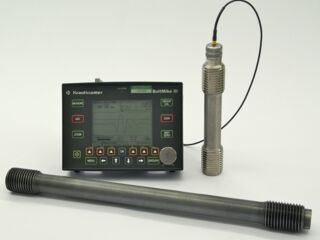
Flange Assembly Services
Professional assembly is the basic requirement for a tight and secure flange connection. Due to decades of experience in the development of assembly tools, the support of our customers in using these tools and the integration of innovative processes, we can support you in the assembly of flange connections. In particular, the measurement of the bolt forces during the assembly process is the focus of our services.
Whether measuring the bolt elongation with one of our hydraulic methods TEMESokto.ms, TEMESokto.mu or TEMESokto.rc or with an ultrasonic measuring device, at the end of the assembly you know exactly which bolt force - and thus also which gasket force - was applied to the connection . And by using our self-developed software, these forces can not only be measured but also stored, so that you always have perfect documentation.
Ultrasonic measurement of bolt forces

Ultrasound can be used to record the prestresses in the bolts during assembly.
Measurement is carried out using the pulse-echo method. A test head is connected to the end face of the bolt. It transmits an ultrasonic pulse, which runs longitudinally along the bolt and is reflected at the opposite end as an echo which subsequently returns to the test head. The time for the ultrasonic pulse to travel between each end of the bolt is used to measure the bolt. This enables changes in this time to be recognized while the bolt is being tightened (loaded). In the elastic range, this time increases linearly with the elongation. There are two components contributing to this:
- the direct increase in length of the bolt ΔL
- the acoustic-elastic effect i.e. the reduction Δv of the acoustic velocity v due to the elastic stresses in the bolt.
Just as for mechanical stress, temperature also influences the acoustic cycle time. There is a linear relationship between the change of the acoustic velocity and the temperature change. Therefore, for precise measurement, it is absolutely necessary to compensate for temperature effects.
The initial measurement (zero/reference measurement) is performed on the non-tightened bolt. After conversion with the material-specific acoustic velocity (the geometrical data and material characteristics of the bolt must be entered in advance), the result is displayed as a reference length and saved in the unit. After the bolt has been tightened, the cycle time increases due to the change in length and the acoustic-elastic effect. The ultrasonic measurement unit – which is equipped with a microprocessor – determines the appropriate difference to the reference measurement and converts this into force, stress and elongation using appropriate formulae.
Concurrently with the cycle time measurement, a temperature sensor connected to the unit measures the temperature of the bolt. All the cycle time values are automatically converted to 22 °C, so temperature changes do not influence the measurement results.
Your contact for all assembly services
Benjamin Schiefer
Tel.: +49 7133 9502-261
E-Mail: temes@amtec.de
